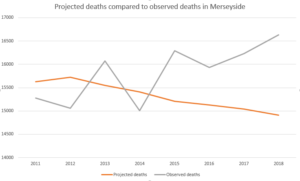A new study by the University of Liverpool has linked austerity to 231,707 excess deaths in England over a period of eight years.
The 2010-2018 study established that there were more deaths in areas where the financial loss due to austerity was greater.
The impact of austerity policies from the coalition and Conservative governments during that period were felt most harshly in already deprived areas, including Liverpool.

The policies impacted local authority spending on adult social care, leading to less support for pensioners.
Excess deaths are calculated as the gap between the life expectancy predicted by Office of National Statistics and data from local authorities on what actually occurred.
There were more deaths than expected in over 90% of local authorities, and 90% of those occurred after 2014.
Analysis showed that more deaths occurred in areas where the impact of welfare reforms and fiscal austerity policies was greater.
These areas saw an excess of deaths for all older people and widened social inequalities for younger people.
In total, 89% of these excess deaths occurred after 2014.
Dr Frances Darlington-Pollock, Lecturer in Population Geography at the University of Liverpool, said: “We are not saying austerity caused more people to die.
“No demographer would expect to be spot on with numbers. But our study estimates that there were 230,000 more deaths than expected and this should set alarm bells ringing.”
She added: “This study raises important questions about how the Government responds to the economic challenges in the aftermath of Covid-19.”
Feature image courtesy of RuaraidhG










